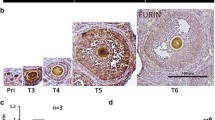Abstract
To elucidate the essential role ofbcl-2 in female reproductive organs,bcl-2-deficient mice (bcl-2 −/− mice), heterozygotes (bcl-2 +/−), and wild-type (bcl-2 +/+) mice were investigated. The ovaries of 4-week-oldbcl-2 −/− mice contained only preantral follicles, although follicles in various developmental stages were present in the ovaries of both 7-and 12-week-oldbcl-2 −/− mice. The number of apoptotic granulosa cells inbcl-2 −/− mice was higher than in both thebcl-2 +/− and thebcl-2 +/+ mice. The uteri of thebcl-2-deficient mice were characterized by growth retardation, including a lack of bifurcation of the organ and poorly developed lamina propria and myometrium. The most interesting finding was the presence of apoptotic cells in both the glandular epithelium and the myometrium. Therefore,bcl-2 is an essential gene for the survival of ovarian granulosa cells and of both endometrial glandular cells and myometrial smooth muscle cells in the uteri.
Similar content being viewed by others
References
Billig H, Furuta I, Hsueh AJW (1993) Estrogens inhibit and androgens enhance ovarian granulosa cell apoptosis. Endocrinology 133:2204–2212
Peluso JJ, Pappalardo A (1994) Progesterone and cell-cell adhesion interact to regulate rat granulosa cell apoptosis. Biochem Cell Biol 72:547–551
Tilly JL, Tilly KI, Kenton ML, Johnson AL (1995) Expression of members of the bcl-2 gene family in the immature rat ovary: equine chorionic gonadotropin-mediated inhibition of granulosa cell apoptosis is associated with decreased Bax and constitutive bcl-2 and bcl-xtong messenger ribonucleic acid levels Endocrinology 136:232–241
Otsuki Y, Misaki O, Sugimoto O, Ito Y, Tsujimoto Y, Akao Y (1994) Cyclic bcl-2 gene expression in human uterine endometrium during menstrual cycle. Lancet 344:28–29.
Gompel A, Sabourin JC, Martin A, Yaneva H, Audouin J, Decroix Y, Poitout P (1994) Bcl-2 expression in normal endometrium during the menstrual cycle. Am J Pathol 144:1195–1202
Hockenbery D, Nunez G, Milliman C, Schreiber RD, Korsmeyer SJ (1990) Bcl-2 is an inner mitochondrial membrane protein that blocks programmed cell death. Nature (Lond) 348:334–336
Hockenbery D, Zutter M, Hickey W, Nahm M, Korsmeyer SJ (1991) BCL-2 protein is topographically restricted in tissues characterized by apoptotic cell death. Proc Natl Acad Sci USA 88:6961–6965
Chinnaiyan AM, Orth K, O'Rourke K, Duan H, Poirier GG, Dixit VM (1996) Molecular ordering of the cell death pathway. J Biol Chem 271:4573–4576
Oltvai ZN, Milliman CL, Korsmeyer SJ (1993) Bcl-2 heterodimerizes in vivo with a conserved homolog. Bax, that accelerates programmed cell death. Cell 74:609–619
Kamada S, Shimono A, Shinto Y, Tsujimura T, Takahashi T, Noda T, Kitamura, Kondoh H, Tsujimoto Y (1995) Bcl-2 deficiency in mice leads to pleiotropic abnormalities: accelerated lymphoid cell death in thymus and spleen, polycystic kidney, hair hypopigmentation, and distorted small instestine. Cancer Res 55:354–359
Veis DJ, Sorenson CM, Shutter JR, Korsmeyer SJ (1993) Bcl-2-deficient mice demonstrate fulminant lymphoid apoptosis, polycystic kidneys, and hypopigmented hair. Cell 75:229–240
Hsu SY, Lai RJM, Finegold M, Hsueh AJW (1996) Targeted overexpression of bcl-2 in ovaries of transgenic mice leads to decreased follicle apoptosis, enhanced folliculogenesis and increased germ cell tumorigenesis. Endocrinology 137:4837–4843
Chao DT, Linette GP, Boise LH, White LS, Thompson CB, Korsmeyer SJ (1995) Bcl-xL and Bcl-2 repress a common pathway of cell death. J Exp Med 182:821–828
Yang E, Zha J, Jockel J, Boise LH, Thompson CB, Korsmeyer SJ (1995) Bad, a heterodimerie partner for Bcl-xL and Bcl-2, displaces Bax and promotes cell death. Cell 80:285–291
Chittenden T, Flemington C, Houghton AB, Ebb RG, Gallo GJ, Elangovan B, Chinnadurai G, Lutz RJ (1995) A conserved domain in Bak, distinct from BH1 and BH2, mediates cell death and protein binding functions. EMBO J 14:5589–5596
Takayama S, Sato T, Krajewski S, Kochel K, Irie S, Millan JA, Reed JC (1995) Cloning and functional analysis of BAG-1: a novel bcl-2-binding protein with anti-cell death activity. Cell 80:279–284
Zhou P, Qian L, Kozopas KM, Craig RW (1997) Mcl-1, a Bcl-2 family member, delays the death of hematopoietic cells under a variety of apoptosis-inducing conditions. Blood 89:630–643
Krajewski S, Bodrug S, Krajewska M, Shabaik A, Gascoyne R, Berean K, Reed JC (1995) Immunohistochemical analysis of Mcl-1 protein in human tissues. Am J Pathol 146:1309–1319
Author information
Authors and Affiliations
Corresponding author
Rights and permissions
About this article
Cite this article
Daikoku, E., Ito, Y. & Otsuki, Y. The induction of apoptosis in ovaries and uteri ofbcl-2-deficient mice. Med Electron Microsc 31, 68–76 (1998). https://doi.org/10.1007/BF01557783
Received:
Accepted:
Issue Date:
DOI: https://doi.org/10.1007/BF01557783




